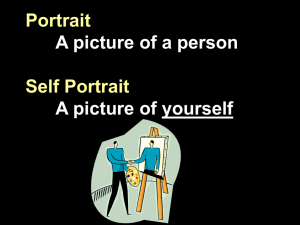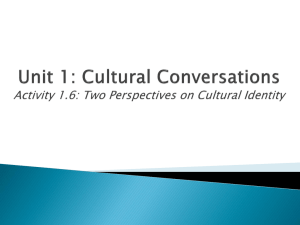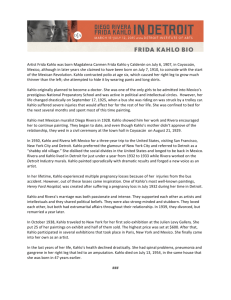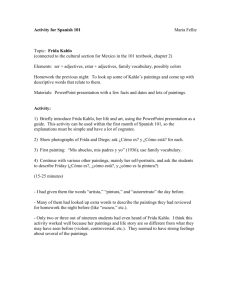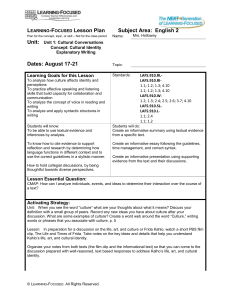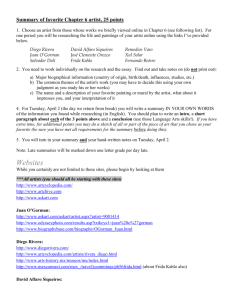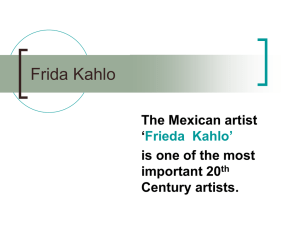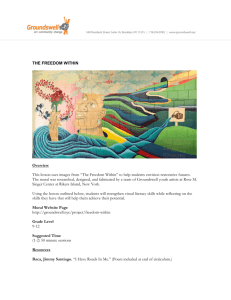Book AK—Frida: A Biography of Frida Kahlo Discussion Guide
advertisement
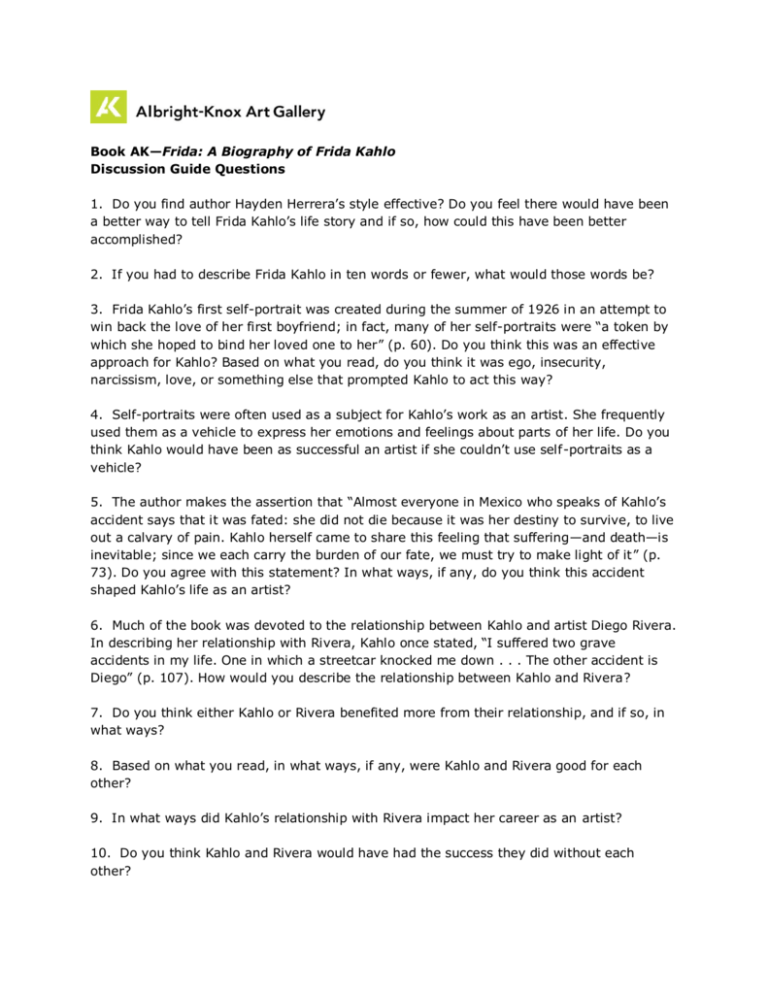
Book AK—Frida: A Biography of Frida Kahlo Discussion Guide Questions 1. Do you find author Hayden Herrera’s style effective? Do you feel there would have been a better way to tell Frida Kahlo’s life story and if so, how could this have been better accomplished? 2. If you had to describe Frida Kahlo in ten words or fewer, what would those words be? 3. Frida Kahlo’s first self-portrait was created during the summer of 1926 in an attempt to win back the love of her first boyfriend; in fact, many of her self-portraits were ―a token by which she hoped to bind her loved one to her‖ (p. 60). Do you think this was an effective approach for Kahlo? Based on what you read, do you think it was ego, insecurity, narcissism, love, or something else that prompted Kahlo to act this way? 4. Self-portraits were often used as a subject for Kahlo’s work as an artist. She frequently used them as a vehicle to express her emotions and feelings about parts of her life. Do you think Kahlo would have been as successful an artist if she couldn’t use self-portraits as a vehicle? 5. The author makes the assertion that ―Almost everyone in Mexico who speaks of Kahlo’s accident says that it was fated: she did not die because it was her destiny to survive, to live out a calvary of pain. Kahlo herself came to share this feeling that suffering—and death—is inevitable; since we each carry the burden of our fate, we must try to make light of it‖ (p. 73). Do you agree with this statement? In what ways, if any, do you think this accident shaped Kahlo’s life as an artist? 6. Much of the book was devoted to the relationship between Kahlo and artist Diego Rivera. In describing her relationship with Rivera, Kahlo once stated, ―I suffered two grave accidents in my life. One in which a streetcar knocked me down . . . The other accident is Diego‖ (p. 107). How would you describe the relationship between Kahlo and Rivera? 7. Do you think either Kahlo or Rivera benefited more from their relationship, and if so, in what ways? 8. Based on what you read, in what ways, if any, were Kahlo and Rivera good for each other? 9. In what ways did Kahlo’s relationship with Rivera impact her career as an artist? 10. Do you think Kahlo and Rivera would have had the success they did without each other? 11. Kahlo made many allowances for Rivera during the course of their relationshi p—living in two separate but linked houses and publically accepting his affairs while keeping her affairs secret due to his jealousy. After reading this biography, are you surprised by Kahlo’s ability to make these allowances? Why do you think that she behaved in this way? 12. While in California with Rivera in 1931, Kahlo painted an important work, Luther Burbank, a portrait of the famous horticulturist who is depicted as a hybrid half-tree, halfman figure. The author asserts how this painting was ―. . . the first indication that Frida Kahlo was to become a painter of fantasy rather than a painter of straightforward, relatively realistic portraits‖ (p. 123). Based on what you read, why do you think Kahlo made the turn from straightforward, realistic portraits to more surrealist works? Do you think her time in America had any impact on this turn? 13. Throughout the book, the author cites instances of Kahlo’s dislike of America including her letter to Dr. Eloesser on May 26, 1932, in which Kahlo wrote, ―The industrial part of Detroit is really most interesting, the rest is, as in all of the United States, ugly and stupid‖ (p. 136). Why do you think Kahlo so disliked America? Do you think her assessments of America were fair? Are these feelings hypocritical considering how many Americans supported her and her success in America throughout her lifetime? 14. Kahlo suffered many tragedies, not the least of which was her 1925 trolley accident and her subsequent inability to have children. She used these health issues and her great physical suffering as themes in many of her paintings. Do you think Kahlo would have been such an innovative painter and have been so successful if she had not suffered such great health tragedies? Do you think in a broader sense the occurrence of great tragedies shaping art is true of the lives of many great artists? 15. In your opinion, where does Kahlo rank among female artists? Do you think that she should be considered a feminist? 16. The author details how even her friends have noted that Kahlo’s ―…most passionate love affair was with herself‖ (p. 199). Considering Kahlo’s active love life and her many affairs with both men and women, do you agree with this statement? 17. In describing Kahlo’s approach to painting and her lack of complete focus on it, the author makes the claim that Kahlo ―…preferred to be seen as a beguiling personality rather than be judged as a painter. Her paintings expressed, in the most vivid and direct way possible, her reality; making them was only part of, and no more important than, making and being Frida Kahlo‖ (p. 226). Do you agree with this statement? Is it a fair assessment for the artist to make and if so, does it conflict with or support her actions surrounding and her interest in her major exhibition in Mexico near the end of her life? 18. Kahlo often relied on or incorporated her Mexican identity into her art. Do you think she was simply instinctual or do you think this was a strategic move on her part? Why? 19. Kahlo was often linked to the Surrealist art movement, sometimes embracing it and sometimes rejecting it. Based on what you read, do you think Kahlo’s links to Surrealism were coincidental or was she knowingly using surrealist elements to further her career and popularity as an artist? 20. Much was written in this book about Kahlo’s and Rivera’s involvement in politics. In what ways do you think Kahlo’s political beliefs strengthened or hurt her work as an artist? Would you consider Kahlo a political artist? 21. A portion of this book is devoted to discussing Kahlo’s work as a teacher at La Esmeralda. Was her relationship with her students in line with everything else you read about Kahlo’s life and personality? In what ways did Kahlo’s life experiences shape her teaching style? 22. Would you consider Kahlo to be an autobiographical artist? 23. What role does symbolism play in Kahlo’s art? Was Kahlo’s use of symbolism effective? 24. Regarding Kahlo’s constant invalidism and repeated surgeries, the author writes that It is possible to argue that invalidism was essential to her self-image, and that if Frida’s physical problems had been as grave as she made out, she would never have been able to translate them into art. No less an authority than Dr. Eloesser believed that most of Frida’s surgical operations were unnecessary, that she was caught in a familiar psychological syndrome that impels patients to want surgery. After all, an operation is a way of getting attention. Many people believe that Rivera would have left Frida had she not been so sick, and Frida was quite capable of consenting to an unnecessary operation if it would strengthen her hold on Diego. (p. 346–47) Do you agree with this argument? If Kahlo’s art came from her pain, would she have been an artist without her pain, real or imagined?
